Between Arkansas and Missouri, there are over 40 different snake species. While many of them overlap, a few don’t. However, we’re concerned with which snakes live near the White River, so that’s where we focus.
All 722 miles of the White River flow through just two U.S. States — Arkansas and Missouri. It begins in northwest Arkansas, flowing northeast into southern Missouri before turning southeast, where it winds its way to the mighty Mississippi River.
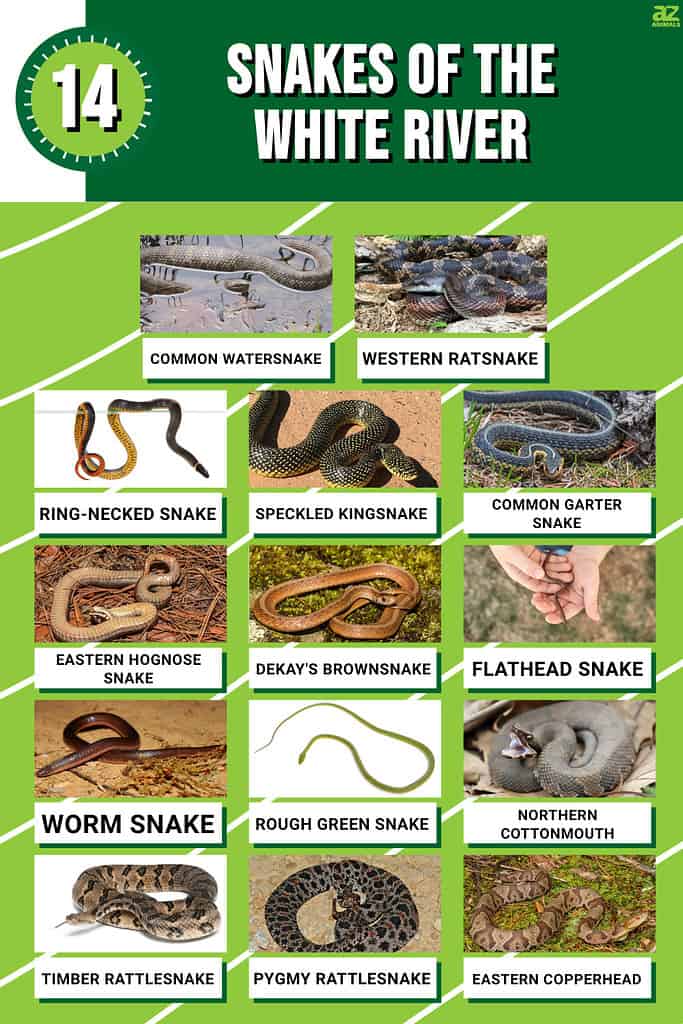
Using iNaturalist.org as a guide, let’s discover which snakes you’re most likely to encounter while exploring the White River in Arkansas and Missouri.
When Are Snakes Most Active Around the White River?
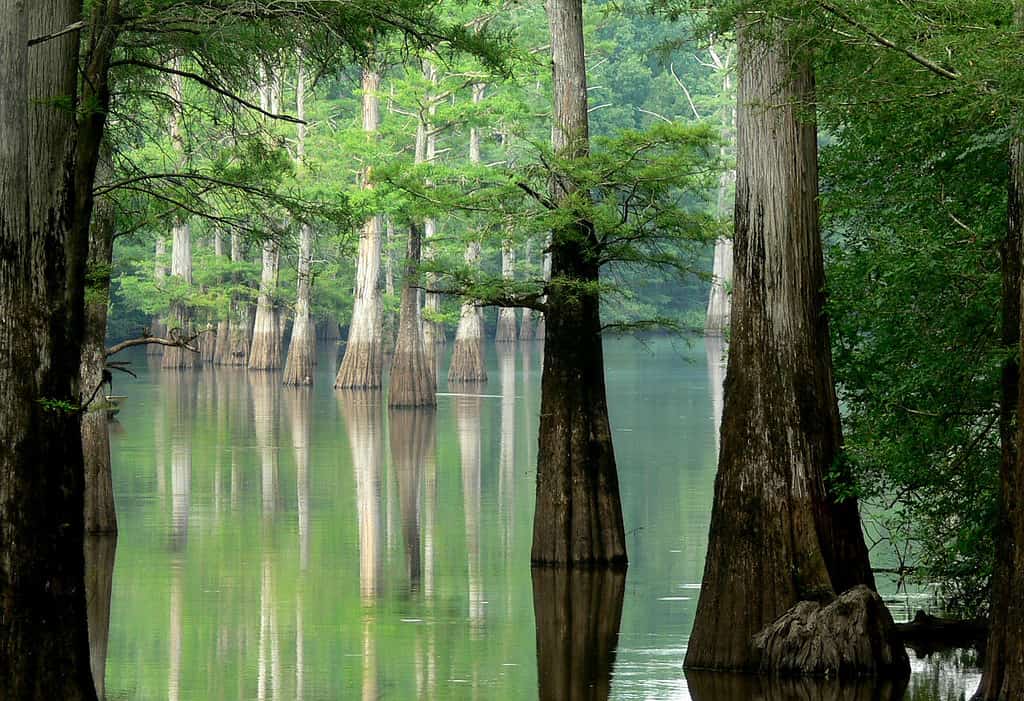
One of the biggest bald cypress trees is located in the White River National Wildlife Refuge in eastern Arkansas, and 90 miles of the White River flows through the area.
©Linda Tanner (flickr user: goingslo), CC BY 2.0 – License
Being cold-blooded, snakes tuck themselves away during the winter months. For most species around the White River, the weather gets too cold by mid to late October and warms up again in March or April.
While you can see a snake at any time during its active periods, you are more likely to see snakes during fall and spring when they’re moving to or from brumation spots. Some species, like racers and timber rattlesnakes, use the same location every year and share it with other snakes. Others tuck themselves in wherever they can.
Even though they’re sleeping through the winter cold and do not eat, they still need to drink. So, on warm winter days, it’s common for a snake to slither out of its winter accommodations and bask a little before they take a drink of water.
1. Common Watersnake (Nerodia sipedon)
By far, the most common snake you’ll find around the White River is the common water snake. Also called the northern watersnake, this fish and frog eater can grow up to four and a half feet long but usually stays a bit smaller. Common water snakes are feisty with very sharp teeth, and they’re quick to bite when you corner them. They’re more common in the shallows or basking on branches that overhand the water.
People often confuse watersnakes for venomous cottonmouths. However, these nonvenomous snakes don’t have venom to do any permanent damage.
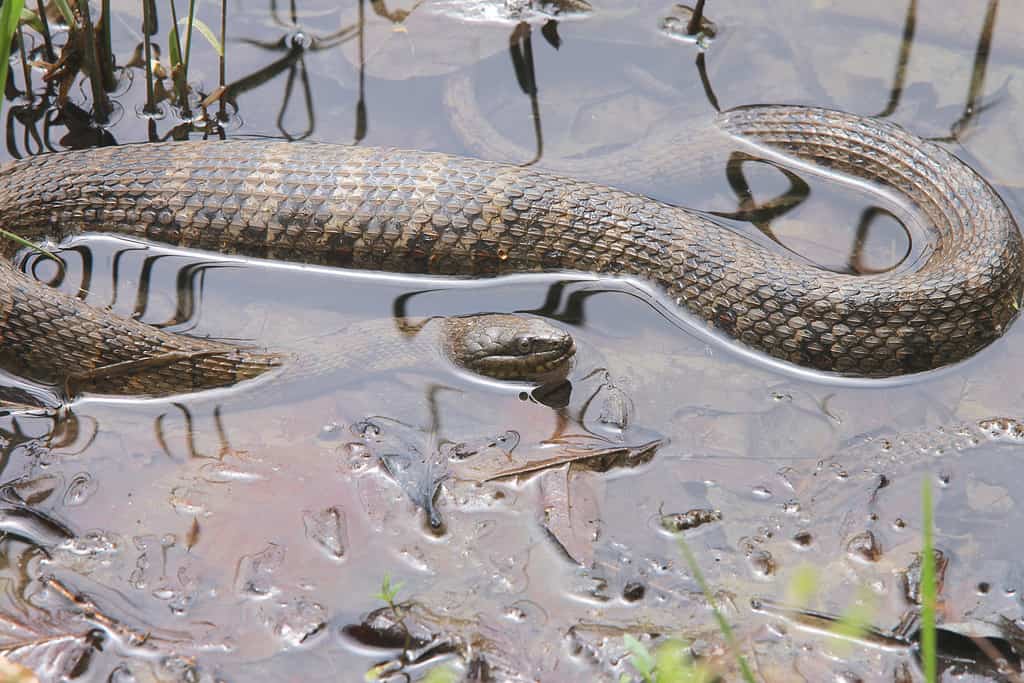
A Northern Water Snake (Nerodia sipedon) lays in shallow water at the edge of a lake. Its heavy body and keeled scales make people confuse them for cottonmouths.
©iStock.com/NajaShots
2. Western Ratsnake (Pantherophis obsoletus)
Although harmless, they can bite if threatened. However, they’re more likely to coil up and bluff before biting. Western rat snakes are fairly large and can reach six feet long. These snakes are muscular and outstanding climbers that get into all sorts of trouble. People find them in trees, yards, and more, but around the White River, these snakes are most likely in the trees and shrubs, looking for rodents and birds. Western rat snakes are common throughout most of their range in the midwestern United States south into Texas and Louisiana.
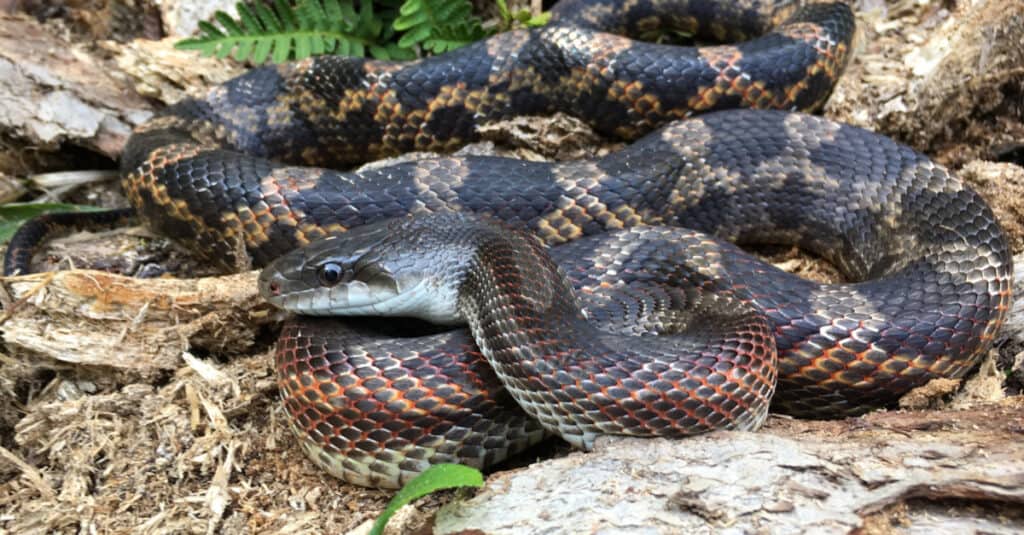
Western rat snakes come in many colors but darken with age and lose some of their patterns.
©Joe Farah/Shutterstock.com
3. Ring-Necked Snake (Diadophis punctatus)
These snakes are small and hide under moist leaf litter, rotten logs, and other dark places where they can find their favorite foods — slugs, snails, small lizards, and earthworms. Ring-necked snakes are a solid, dark color on their backs that ranges from greenish-gray to black. Their common name comes from the fact that they have a contrasting ring around their necks that matches their equally bright-colored belly color of red, orange, yellow, or cream.
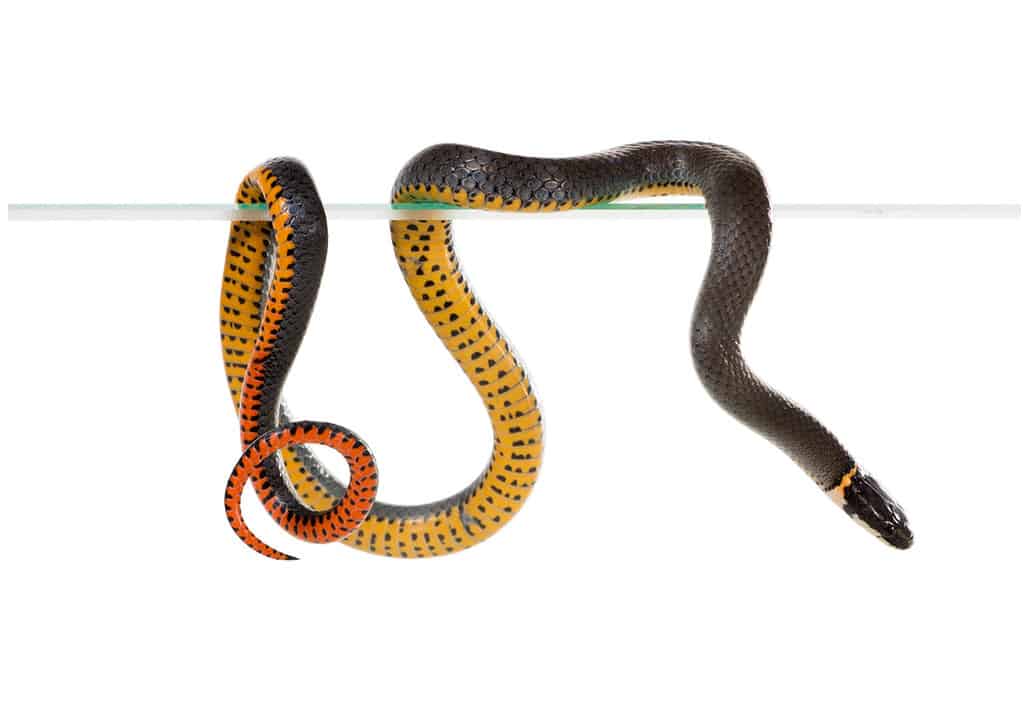
These snakes sometimes coil their tail, showing their bright belly color.
©IrinaK/Shutterstock.com
4. Speckled Kingsnake (Lampropeltis holbrooki)
Kingsnakes are generally pretty snakes. You’ll have red, black, and white banding, black and white, solid black, and more, depending on which kingsnake species you see. However, speckled kingsnakes are one of the prettiest.
Speckled kingsnakes are jet-black with bright yellow to cream spots all over their bodies and yellow bellies. They’re muscular snakes that love eating other snakes — including venomous species — but also eat various other animals like mice and rats. This species can reach six feet long but often stays a bit smaller. These snakes are found along most of the White River’s length.
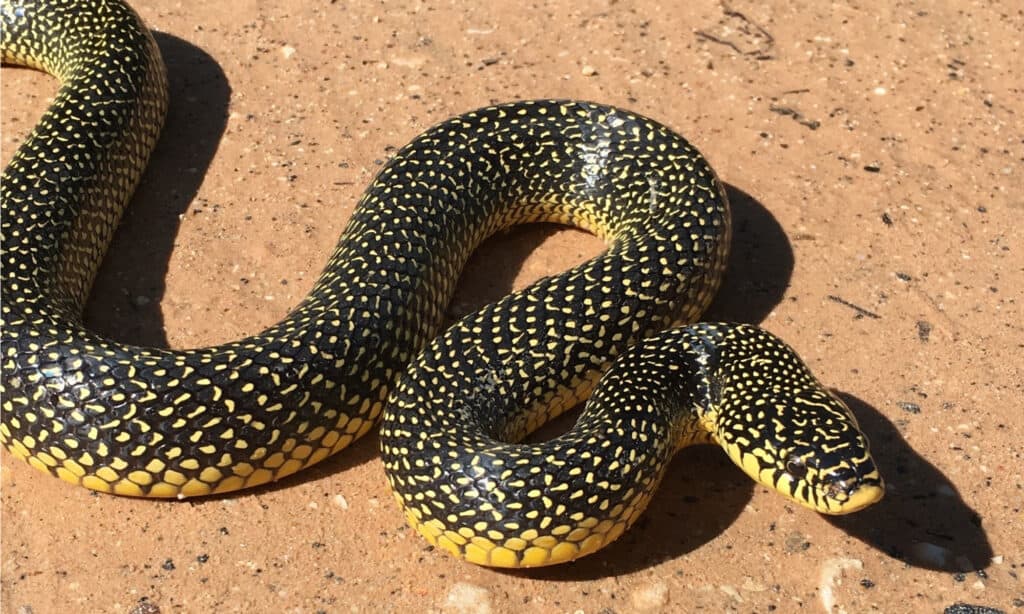
The Speckled Kingsnake has a glossy black body with whitish-yellow dots on its scales.
©Joe Farah/Shutterstock.com
5. Common Garter Snake (Thamnophis sirtalis)
These sometimes four-foot-long snakes prefer wet habitats like those around rivers, lakes, and ponds. Common garter snakes eat a variety of prey, including frogs, fish, tadpoles, and earthworms. Although previously believed to be nonvenomous. Recent research shows that their saliva is mildly venomous and helps subdue small prey.
Common garter snakes are more widespread across North America and even thrive farther north than other species.

These sometimes smelly snakes release horrible-smelling musk when threatened.
©iStock.com/Wildnerdpix
6. Eastern Hognose Snake (Heterodon platirhinos)
The drama queen of the snake world is here! Eastern hognose snakes are mildly venomous to their prey but harmless to humans. They can reach four feet long but usually stay much smaller at around two or three feet. This species is a toad specialist. Eastern hognose snakes prefer amphibians, especially toads, over almost all other prey. It’s really hard to get a wild snake to take the rodents keepers typically offer.
These snakes play dead as a way to avoid predators. They’ll even go so far as to release musk and spread it all over themselves. At the end of the act, they flip onto their backs, leaving their mouth wide open and tongues hanging out.
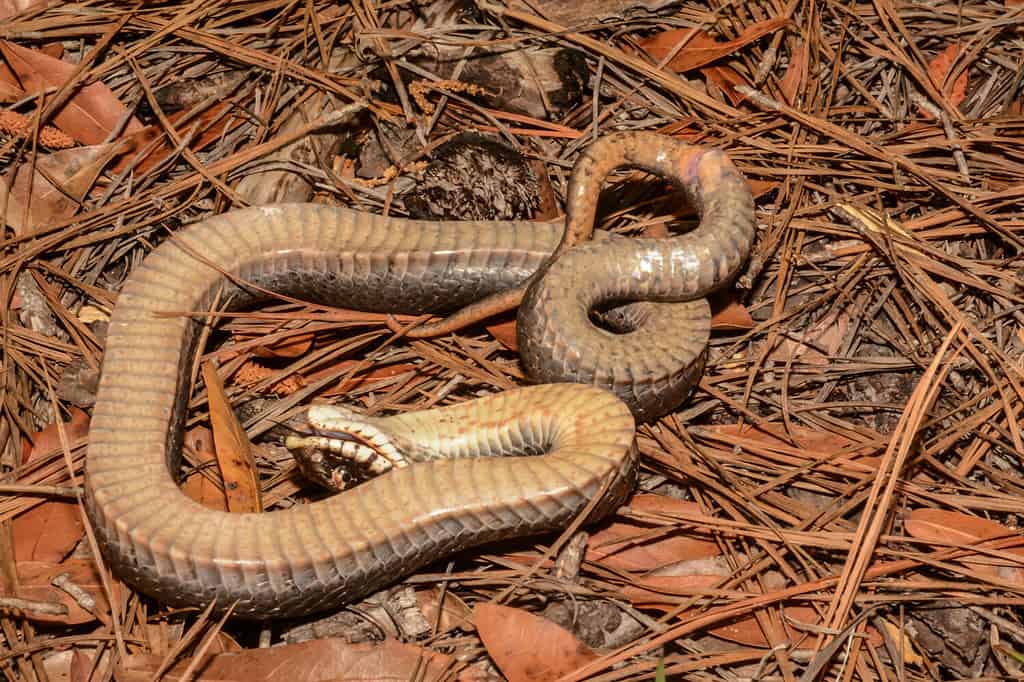
No, it isn’t dead. A hognose will stay this way until the coast is clear when it can move along.
©Jay Ondreicka/Shutterstock.com
7. Dekay’s Brownsnake (Storeria dekayi)
As small as these harmless snakes are, many people mistake them for juveniles of another species. However, the very biggest Dekay’s brownsnake ever found measured about 19 inches long, and most never exceed 14.
They’re snail and slug eaters that spend more time under rocks, moist leaf litter, and rotten logs than slithering around. In fact, turning over logs and other ground cover is probably the only time you’ll see a Dekay’s brownsnake.
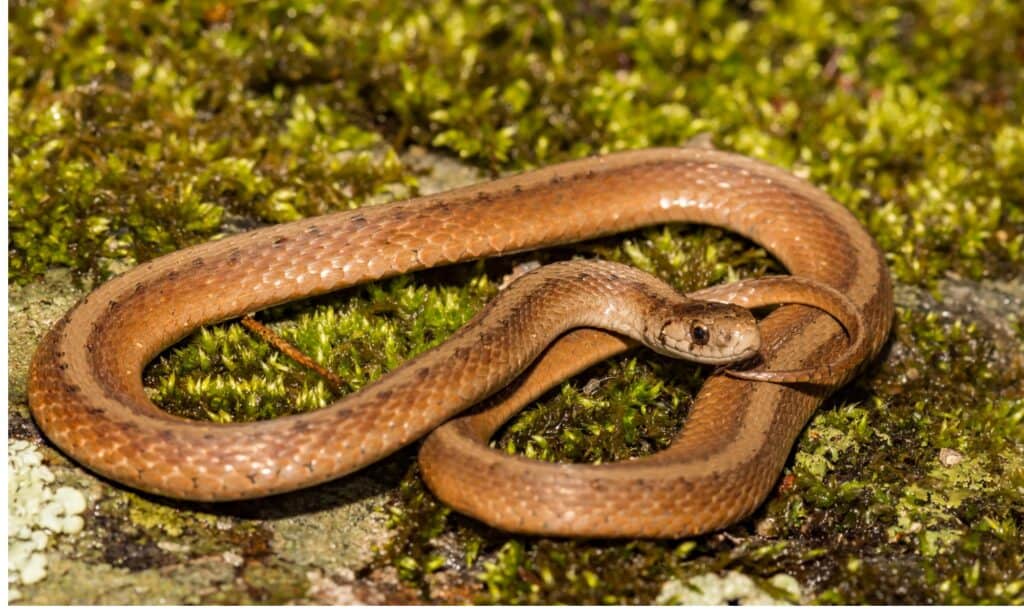
Dekay’s brownsnakes are docile and almost never bite. Even if they do, these harmless snakes aren’t strong enough to cause damage.
©iStock.com/JasonOndreicka
8. Flathead Snake (Tantilla gracilis)
Tantilla genus snakes are small. So small that, like Dekay’s brownsnakes, they’re sometimes mistaken for babies of another species. However, flathead snakes are just small. They rarely get longer than eight inches and usually have a darker head (but not black). Flatheads have slightly flattened heads, brown to gray bodies, and pinkish belly.
These somewhat fossorial snakes are usually found under rocks and logs after it rains. These harmless snakes usually eat centipedes, spiders, scorpions, and other insects.
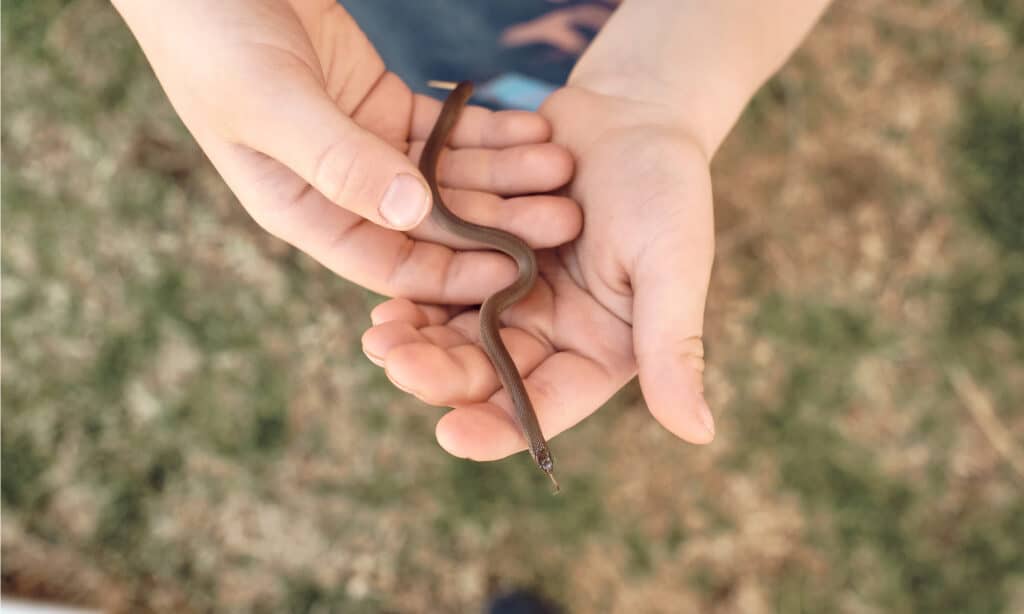
Flathead snakes are completely harmless and probably won’t even try to bite.
©MRoald/Shutterstock.com
9. Worm Snake (Carphophis amoenus)
Common names are tricky. You would think that being called the worm snake would put this snake’s territory to the east of the western worm snake’s range. But you would be wrong. This worm snake is more common along the northwestern half of the White River and mainly eats slugs and worms.
These tiny snakes usually grow between 7.5 and 11 inches long. The longest worm snake on record was 13 inches. Worm snakes are almost always underground somewhere because their skin evaporates water too quickly otherwise.

Worm Snakes typically have dark tops and lighter-colored undersides.
©Jason Patrick Ross/Shutterstock.com
10. Rough Green Snake (Opheodrys aestivus)
Beautiful and bright green, rough green snakes are more common along the White River’s shrubs and bushes than on the ground. This snake is often found near water. It’s a completely harmless colubrid that people sometimes call grass snakes.
Although thin, they can grow up to 45 inches long. However, because of their bright green dorsal color and yellowish belly, they camouflage well. This spring-green-colored snake is usually active during the day and eats a variety of insects and arthropods, with an occasional tree frog for variety.

Long and thin, rough green snakes are excellent swimmers and climbers.
©Melinda Fawver/Shutterstock.com
11. Northern Cottonmouth (Agkistrodon piscivorus)
A fairly common snake around the White River is also the only venomous semiaquatic snake in North America. It has a fearsome reputation — but it’s just frightened of people. Northern cottonmouth snakes are slow and not-so-elegant on the land but as graceful as a ballerina in the water. Their land movement notwithstanding, cottonmouths have one of the fastest strikes in nature.
Easily identified by their pixellated pattern, dark mask, and angular head, cottonmouths are rarely found far from water. Their scientific name roughly translates to “hook-toothed fish eater,” if that’s any indication! Cottonmouths can get fairly big, up to six feet, but the average length is closer to three feet long.
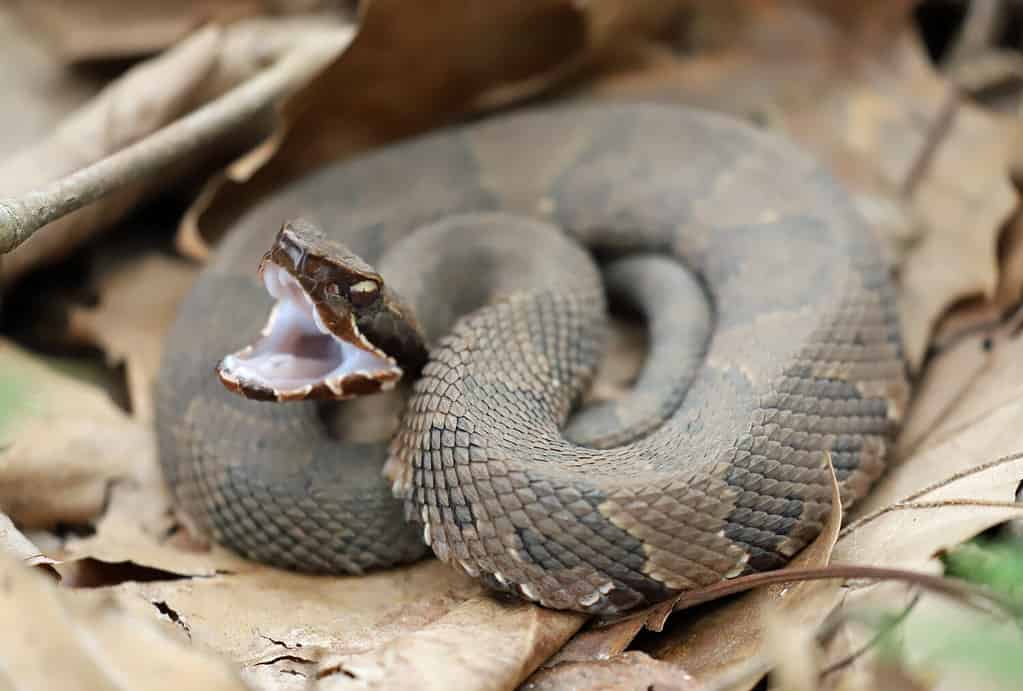
They’re called cottonmouths because the inside of their mouth is cotton-white, and they display it as a warning to back off.
©KF2017/Shutterstock.com
12. Timber Rattlesnake (Crotalus horridus)
While not as common as other snakes around the White River, timber rattlesnakes deserve a mention. They’re one of the biggest rattlesnakes in North America. Some reach six feet long. These snakes are also excellent swimmers and are perfectly willing to take a swim to get their next meal.
Timber rattlers are ambush predators that usually sit and wait for their food, striking from a hidden location. However, although these are venomous snakes, they’re not aggressive. In fact, they’re shy and don’t often bite. Many times they won’t even rattle until you’re on top of them.
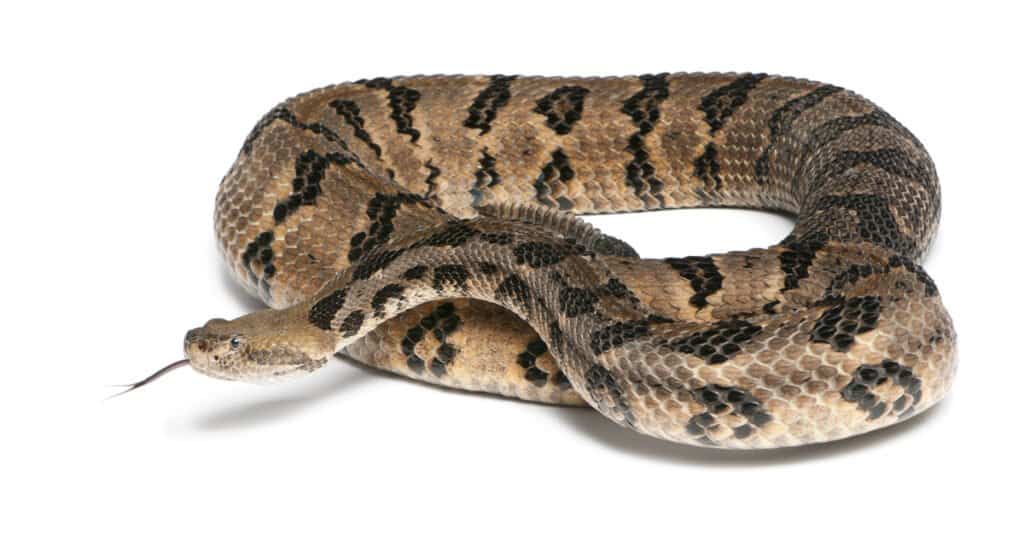
Timber rattlesnakes are highly venomous, very shy, and not likely to bite unless directly harassed.
©fivespots/Shutterstock.com
13. Pygmy Rattlesnake (Sistrurus miliarius)
These snakes are most common in the northwestern end of the White River and eat small rodents. They’re called pygmy rattlesnakes not because they’re small rattlesnakes that only measure about two feet long but because their rattles are small. Pygmy rattlesnakes are shy and don’t bite often. They are venomous, just like all other rattlesnakes, but bites are rare, and they don’t inject much.
Although seeing this snake along the White River is rare, pygmy rattlesnakes do live there. However, unlike copperheads, pygmy rattlesnakes enjoy moist, marshy areas. You’ll find these snakes in grassy, wet areas like those around the edges of the river.
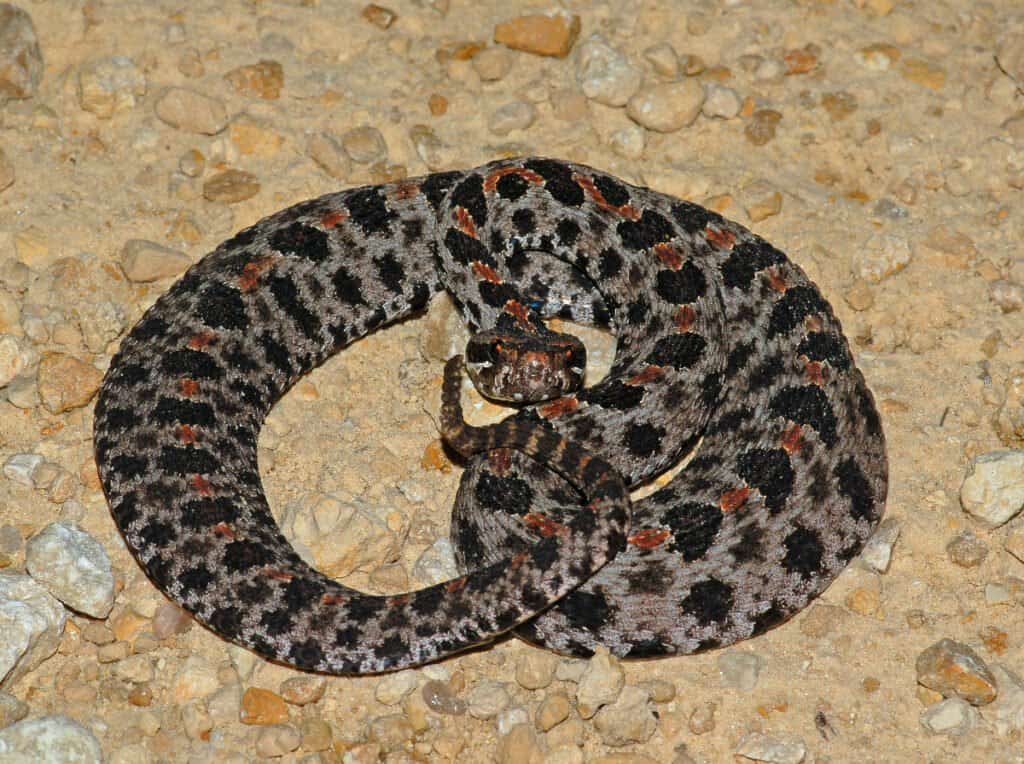
These snakes have tiny rattles that make a high-pitched buzzing sound.
©Gerald A. DeBoer/Shutterstock.com
14. Eastern Copperhead (Agkistrodon contortrix)
Even though these pit vipers are gorgeous snakes, they are venomous! Copperhead snakes are common around the White River but aren’t as fond of water as other snakes. These snakes prefer open forested areas with a lot of leaf litter where their pattern helps them camouflage perfectly. Their highly effective camouflage, combined with their inclination to freeze in place, makes them a higher risk for being stepped on — explaining why copperheads cause almost half the venomous snakebites in the U.S. each year.
Fortunately, these snakes don’t have the most dangerous venom, and most people recover without permanent damage. They’re also pretty reluctant to bite, despite the numbers. Copperheads are far more interested in being left alone than wasting their precious venom on something they can’t eat — which is true for most venomous snakes.

They possess some incredible camouflage that makes them seem almost invisible on the forest floor.
©JacobLoyacano/Shutterstock.com
Can You Swim in the White River?
In many areas, yes, but check local water authorities for water quality reports first. Sometimes weird bacteria or algae show up, and it’s safer to take a rain check on swimming. The White River has lots of opportunities for boating, hiking, canoeing/kayaking, swimming, hunting, and fishing. With that much variety, you’ll find something to explore.
One popular area for hiking is the White River National Wildlife Reserve. You can see all sorts of plants and animals and even some of the biggest (and oldest!) living bald cypress trees in the world.
Other Animals that Live Along the White River
Of course, snakes aren’t the only animals that live around the White River. That would be boring. The region is full of life, from the very small to the very large. You could see deer, rabbits, mice, frogs, coyotes, insects, and thousands of other species.
- American Black Bear: native to North America, the black bear is relatively common in the northwestern reaches of the White River. They are omnivores and eat anything available, including digging through trash and raiding cars or homes. Some have become dangerous because they follow people looking for food.
- Northern Cardinal: the males of this species are impossible to miss! Their bright-red plumage grabs your attention, no matter what time of year.
- North American Luna Moth: this stunning moth is common in the eastern half of the United States. It’s also called the American moon moth and can have a seven-inch or more wingspan. Interestingly, they don’t eat as adults. Instead, they rely on fat deposits they developed as caterpillars.
- Downy Woodpecker: The smallest woodpecker species in North America, downy woodpeckers only measure about seven inches from beak to tail. They’re relatively common across Arkansas and Missouri and do well in the forested areas near the White River.
The photo featured at the top of this post is © Linda Tanner (flickr user: goingslo), CC BY 2.0 – License / Original
Discover the "Monster" Snake 5X Bigger than an Anaconda
Every day A-Z Animals sends out some of the most incredible facts in the world from our free newsletter. Want to discover the 10 most beautiful snakes in the world, a "snake island" where you're never more than 3 feet from danger, or a "monster" snake 5X larger than an anaconda? Then sign up right now and you'll start receiving our daily newsletter absolutely free.
Thank you for reading! Have some feedback for us? Contact the AZ Animals editorial team.







